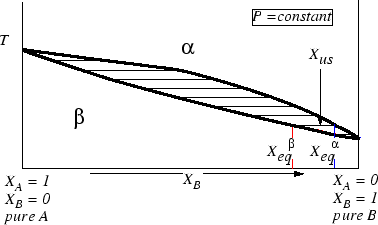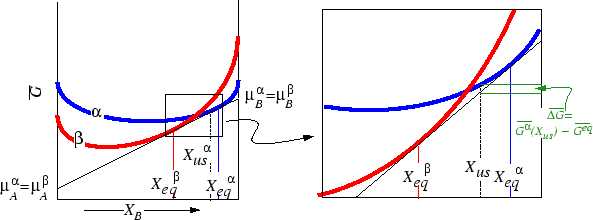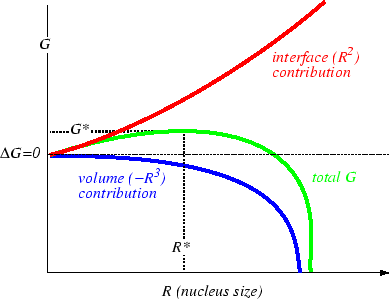Nucleation of a new phase occurs when a phase in
an alloy of composition
![]() is unstable with
respect a composition that is not near
is unstable with
respect a composition that is not near
![]() .
.
 |
The transformation will require nucleation of an
![]() -phase
at a composition that, when combined with the molar free energy of
the resultant
-phase
at a composition that, when combined with the molar free energy of
the resultant
![]() -phase, gives a mixture with a molar Gibbs free
energy that is less than the value of
-phase, gives a mixture with a molar Gibbs free
energy that is less than the value of
![]()
In other words,
![]() at
at
![]() ,
but there is some
,
but there is some
![]() for which
for which
 .
The negative
.
The negative
![]() is the driving force
for the creation of a new phase.
is the driving force
for the creation of a new phase.
 |
Notice that the driving force for the phase transformation goes
away as the unstable composition
![]() approaches the
limiting compositions on the tie-line.
approaches the
limiting compositions on the tie-line.
The driving force for nucleation is important because it
has to be utilized to overcome the additional energy
associated with the interface between the
![]() and
the
and
the
![]() phase.
This is the interfacial energy.
phase.
This is the interfacial energy.
The surface (or interfacial) tension is the amount of energy
that is required to produce interface per unit area interface.
Let the interfacial tension between the
![]() and
the
and
the
![]() phase be
phase be
![]() and suppose
that when the
and suppose
that when the
![]() -phase nucleates, that it forms
a little sphere of radius
-phase nucleates, that it forms
a little sphere of radius
![]() :
:
The total (extensive) extra energy required for the phase transformation is:
| (32-18) |
Therefore the total free energy required to create a nucleus is given by
 |
(32-19) |
where
![]() is the (magnitude) of the
molar driving force to create the nucleating
is the (magnitude) of the
molar driving force to create the nucleating
![]() -phase
and
-phase
and
![]() is its molar volume.
is its molar volume.
Therefore the total energy has contributions from two parts:
 |
If a nucleus can attain a size that exceeds the maximum,
![]() of the
curve in Fig. 32-16, then it can increase
its size while continuously decreasing its free energy--therefore
any nucleus with size
of the
curve in Fig. 32-16, then it can increase
its size while continuously decreasing its free energy--therefore
any nucleus with size
![]() or larger will grow continously.
or larger will grow continously.
To calculate this critical size, take the derivative of Eq. 32-19 and set it equal to zero and solve for
![]() :
:
 |
(32-20) |
and substituting this radius into the expression for the nucleation energy gives the nucleation barrier energy:
 |
(32-21) |
This expression illustrates that nucleation must occur
at a critical size and that the energy barrier to nucleation
can be reduced by a decrease in the interfacial tension or
by an increase in the volumetric driving force.3The time required for the phase transition to occur is related
to the time required for a critical composition fluctuation to
occur that will produce a critical nucleus of size
![]() --and
that time increases exponentially with the barrier
--and
that time increases exponentially with the barrier
![]() .
.